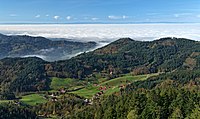
Photo from wikipedia
Abstract In fractured reservoirs in the basement of extensional basins, fault and fracture parameters like density, spacing and length distribution are key properties for modelling and prediction of reservoir properties… Click to show full abstract
Abstract In fractured reservoirs in the basement of extensional basins, fault and fracture parameters like density, spacing and length distribution are key properties for modelling and prediction of reservoir properties and fluids flow. As only large faults are detectable using basin-scale geophysical investigations, these fine-scale parameters need to be inferred from faults and fractures in analogous rocks at the outcrop. In this study, we use the western shoulder of the Upper Rhine Graben as an outcropping analogue of several deep borehole projects in the basement of the graben. Geological regional data, DTM (Digital Terrain Model) mapping and outcrop studies with scanlines are used to determine the spatial arrangement of the faults from the regional to the reservoir scale. The data shows that: 1) The fault network can be hierarchized in three different orders of scale and structural blocks with a characteristic structuration. This is consistent with other basement rocks studies in other rifting system allowing the extrapolation of the important parameters for modelling. 2) In the structural blocks, the fracture network linked to the faults is linked to the interplay between rock facies variation linked to the rock emplacement and the rifting event.
Journal Title: Journal of Structural Geology
Year Published: 2017
Link to full text (if available)
Share on Social Media: Sign Up to like & get
recommendations!